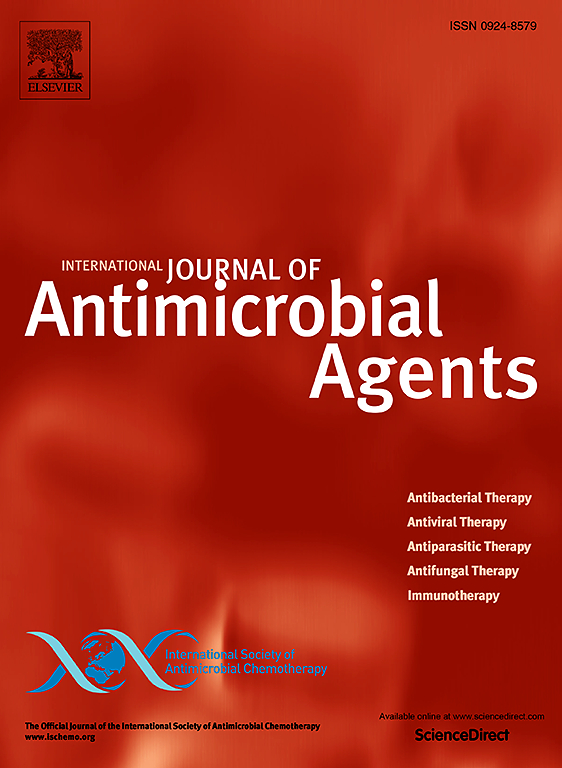咖啡酸异戊酯靶向亚马孙利什曼原虫Gp63(利什曼溶素)。
IF 4.6
2区 医学
Q1 INFECTIOUS DISEASES
International Journal of Antimicrobial Agents
Pub Date : 2025-06-04
DOI:10.1016/j.ijantimicag.2025.107548
引用次数: 0
摘要
利什曼病的治疗采用多种化合物,其毒性、成本和功效因疾病形式而异。然而,新疗法的发展对于扩大治疗选择和解决现有的局限性仍然很重要。在此之前,我们报道了咖啡酸异戊酯(ICaf)对亚马逊利什曼原虫(Leishmania amazonensis)的promastigotes和amastigotes具有有效的活性,但在小鼠模型中没有明显的毒性。本研究研究了ICaf对金属肽酶gp63(利什曼溶素)的影响,这是利什曼原虫的一个关键毒力因子,通过调节宿主免疫反应、降解宿主蛋白质和促进巨噬细胞入侵来支持寄生虫的生存。分子对接分析表明,ICaf与gp63活性位点内的关键氨基酸相互作用,实现了-5.5 kcal/mol的对接得分。gp63-ICaf相互作用通过氢键、疏水相互作用、金属-受体相互作用和范德华力的组合来稳定。实验数据支持这些发现,ICaf显示出典型的剂量依赖性gp63蛋白水解活性抑制,导致IC50为1.51µM, Ki为9.89µM。凝胶电泳证实了gp63-ICaf复合物的稳定形成。此外,用ICaf预处理promastigotes降低了细胞相关的gp63蛋白水解活性,荧光肽底物z - ph - arg - amc和凝胶掺入电泳凝胶的水解降低了这一点。使用抗gp63抗体的流式细胞术和共聚焦显微镜进一步证实了gp63在寄生虫表面的表达降低。总之,这些发现表明,ICaf是一种有希望的对抗利什曼病的策略,为疾病治疗提供了一种潜在的新方法。本文章由计算机程序翻译,如有差异,请以英文原文为准。

Isopentyl caffeate targets Gp63 (Leishmanolysin) in Leishmania amazonensis
Objectives
Several drugs are commonly used in the management of Leishmaniasis, but their toxicity, cost, and efficacy depend on the form of the disease.The development of new therapeutics remains important to expand treatment options and address existing limitations. Previously, we reported that isopentyl caffeate (ICaf) exhibited potent activity against promastigotes and amastigotes of Leishmania amazonensis without notable toxicity in a murine model. This study investigated the effects of ICaf on the metallopeptidase gp63 (leishmanolysin), a key virulence factor in Leishmania that supports parasite survival by modulating host immune responses, degrading host proteins, and facilitating macrophage invasion.
Methods and Results
Molecular docking analysis revealed that ICaf interacted with key amino acids within the active site of gp63, achieving a docking score of -5.5 kcal/mol. The gp63-ICaf interaction was stabilised through a combination of hydrogen bonding, hydrophobic interactions, metal-acceptor interactions and van der Waals forces. Experimental data supported these in silico findings, with ICaf showing a typical dose-dependent inhibition of gp63 proteolytic activity, resulting in an IC50 of 1.51 µM and a Ki of 9.89 µM. The formation of a stable gp63-ICaf complex was demonstrated by gel electrophoresis assay. Furthermore, pretreatment of promastigotes with ICaf reduced cell-associated gp63 proteolytic activity, as evidenced by decreased hydrolysis of the fluorogenic peptide substrate Z-Phe-Arg-AMC and gelatin incorporated into electrophoresis gel. Flow cytometry and confocal microscopy, both using anti-gp63 antibodies, further confirmed a decrease in gp63 expression on the parasite surface.
Conclusions
These findings suggest that ICaf is a promising strategy against leishmaniasis, offering a potential new approach to disease treatment.
求助全文
通过发布文献求助,成功后即可免费获取论文全文。
去求助
来源期刊
CiteScore
21.60
自引率
0.90%
发文量
176
审稿时长
36 days
期刊介绍:
The International Journal of Antimicrobial Agents is a peer-reviewed publication offering comprehensive and current reference information on the physical, pharmacological, in vitro, and clinical properties of individual antimicrobial agents, covering antiviral, antiparasitic, antibacterial, and antifungal agents. The journal not only communicates new trends and developments through authoritative review articles but also addresses the critical issue of antimicrobial resistance, both in hospital and community settings. Published content includes solicited reviews by leading experts and high-quality original research papers in the specified fields.

 求助内容:
求助内容: 应助结果提醒方式:
应助结果提醒方式:


